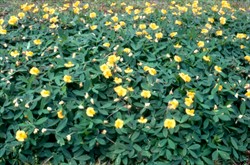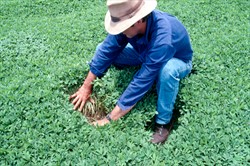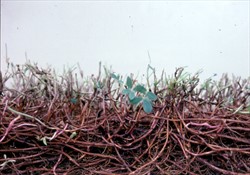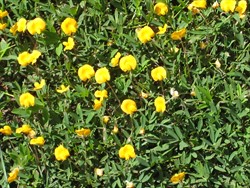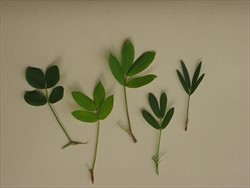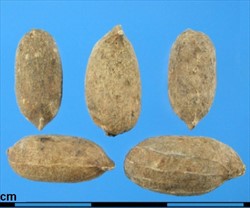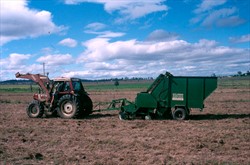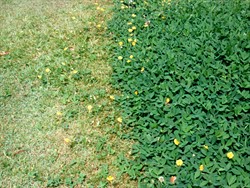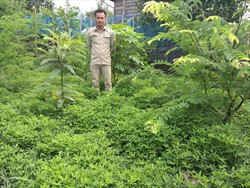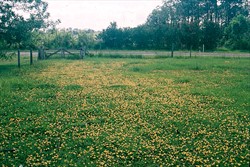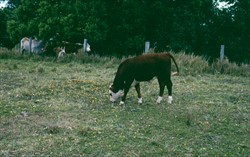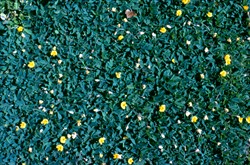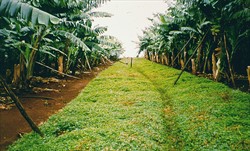Arachis glabrata
Tropical Forages
Arachis glabrata Benth.
Subordinate taxa:
Arachis glabrata Benth. var. glabrata
Arachis glabrata Benth. var. hagenbeckii (Harms) F. J. Herm.
var. hagenbeckii: Arachis hagenbeckii Harms
Note: Epithets such as prostrata and marginata have been misapplied to A. glabrata in the literature.
Family: Fabaceae (alt. Leguminosae) subfamily: Faboideae tribe: Dalbergieae section Rhizomatosae, series Rhizomatosae (formerly Eurhizomatosae).
Very variable even within a single population. Herbaceous, rhizomatous perennial and deep, woody taproot, with rhizomes forming a dense mat in the surface 5‒7 (‒20) cm of soil. Rhizomes 3‒5 (up to10 mm) in diameter, often covered with orange-brown, flaky phellem or bark when mature; in year-old plants rhizomes originate on the basal nodes of the cotyledonary branches. Aerial stems pubescent to glabrous, erect to decumbent, unbranched, hollow or pithy, 2‒3 mm diameter, 5‒30 (‒40) cm long, arising from the crown and rhizomes. Leaves tetrafoliolate, glabrous to sparsely pubescent, stipules linear-lanceolate, falcate, to 3 cm long, villous to glabrescent, sometimes with some bristles; leaflets linear-lanceolate to oblanceolate, obovate or cuneate to 4 cm long and 2 cm wide with margin somewhat marked on the underside; upper leaf surface usually glabrous, but younger leaves may exhibit some very short, scattered hairs; lower leaf surface with adpressed hairs to subglabrous, and frequently with hairs somewhat longer on the midvein. Inflorescence very short, pauciflorous, axillary spike. Flowers sessile, axillary; hypanthium filiform, tubular, to 10 cm long, pilose, with ovary at its base; calyx villous and with abundant bristles; standard more or less orbicular, 15‒25 mm wide, soft orange to brilliant orange (rarely yellow), without red lines on the upper surface but not on back. Fruit set geocarpic, usually scarce, peg 5‒10 cm long; fruit ovoid ca. 10 mm long and 5‒6 mm diameter (sometimes biarticulate with short isthmus), pericarp smooth; seed with pale pink testa.
var. glabrata: leaflets oblong, elliptical or obovate, with the margin somewhat marked on the underside; upper leaf surface usually glabrous, but younger leaves may exhibit some very short, scattered hairs; lower leaf surface with adpressed hairs to subglabrous, and frequently with hairs somewhat longer on the midvein.
var. Hagenbeckii: leaflets linear lanceolate, mostly glabrous.
Description based on Krapovickas and Gregory (1994); translated by Williams DE and Simpson CE (2007).
Native:
South America: Brazil (Goiás, Mato Grosso, Mato Grosso do Sul, Minas Gerais, Sao Paulo); Argentina (Corrientes, Misiones); Paraguay (Alto Paraná, Amambay, Caaguazú, Canindeyú, Central, Concepción, Cordillera, Guaira, Itapúa, Misiones, Paraguarí, San Pedro)
Cutlivated:
Northern America: USA (Florida, Georgia)
Forage
Used in intensively grazed pastures, for hay and silage production, and agroforestry (e.g. under coconuts).
Environment
Soil conservation (e.g. road verges).
Other
Ornamental in gardens. As a cover crop under citrus and other orchard trees. May also have value in companion cropping systems, either with cool or warm season grains.
Soil requirements
Grows successfully on well-drained soils ranging from sands to clays. Prefers acid soils growing well down to pH 4.5, but tolerates neutral to slightly alkaline soils, some ecotypes growing moderately well at pH as high as 8.5. Grows well on infertile or fertile soils, but may suffer from excessive grass competition on the latter. Appears to be less P-demanding than A. pintoi.
Moisture
Rainfall over its natural distribution ranges from about 1,200 to 1,600 mm/yr. In cultivation, it is best suited to areas receiving 1,000‒2,000 mm/yr. It is extremely drought tolerant and can persist in areas receiving well-distributed rain down to 600 mm, or 750 mm rain in a 5-month wet season. During very dry conditions, aerial growth may die off, but rhizomes survive and plants regrow vigorously with the onset of warm and humid weather. It can also tolerate short periods of flooding or waterlogging, surviving in areas with about 4,000 mm rainfall/yr.
Temperature
Natural distribution extends from 13º S to 28º S, mostly at fairly low altitudes. In cultivation, it has grown successfully from near the equator to about 30º N and S, representing a range in average annual temperature of about 20‒26 ºC. While it grows best when mean monthly temperatures are above about 20 °C, it has survived at 32º N in the USA with average annual temperature of 18 ºC, and where "freeze" temperatures may fall to -12 ºC. Heavy frosts kill top growth, but plants recover from rhizomes.
Light
Shade tolerance varies with ecotype, e.g. CPI 12121 rated highly shade tolerant and CPI 29986 as having low shade tolerance. Generally can grow in moderate shade, but less shade-tolerant than A. pintoi.
Reproductive development
Appears to flower in response to shortening days, particularly when released from a stress, e.g. wetting of soil following a dry period. Despite often-dense flowering, few seeds are formed. Seed set is more common during the establishment phase before sward closure or in rhizome production fields the year after digging.
Defoliation
A. glabrata is very tolerant of heavy grazing, requiring moderate to heavy grazing pressures for best performance. For hay production, 3 cuts/yr on an 8-week cycle or 2 cuts/yr on a 12-week cycle give best results. For grazing, best regrowth is obtained with 2,300 kg/ha DM residual (20 cm stubble height) on a 3-week cycle, or 1,500 kg/ha DM residual (15 cm stubble height) on a 6-week cycle.
Fire
As with death of tops from frost and drought, plants readily recover from rhizomes following fire.
Guidelines for establishment and management of sown forages.
Establishment
Due to low levels of seed set, A. glabrata is usually propagated from rhizomes. A clean "seedbed" is preferable since establishment is delayed by competition from associated plants. It is important to use rhizomes that are dormant or have a high level of total non-structural carbohydrate (TNC) to ensure rapid, vigorous establishment. Pieces of rhizome mat 30 cm square can be planted on a 1.5‒2 m grid, or rhizomes can be teased out prior to planting into 15‒25 cm lengths (sprigs), and planted in one of two ways (Note: Rhizome harvesting machinery that digs and separates rhizomes has been developed in Florida, USA). Sprigs can be broadcast over the surface and disked in to the soil, or alternatively, planted in rows, 50 cm to 1 m apart, manually or using sprig-planting machinery, also developed in Florida. In all cases, a planting rate of at least 4.5 m³ of tightly packed or 9 m³ of loosely packed rhizomes/ha (100 bushels/ac) is necessary, planting to a depth of 3 cm in clay soils to 6 cm in coarse sands. Regardless of planting method, fields should be rolled immediately after planting to compact the soil around the rhizomes. There is usually no need to inoculate, since effective strains of Bradyrhizobium are transferred with the planting material. Shoots develop 2‒3 weeks after planting, and full stand cover is possible by the end of the first growing season if rainfall is adequate or irrigation is applied. In many cases, it may take 2‒3 years to achieve a dense cover. Even if seed were available, rhizome planting would probably give faster cover since seedlings are usually quite large before rhizomes form. Weeds should be controlled during establishment by manual weeding or through use of pre-and post-emergence herbicides such as trifluralin or vernolate, post-emergence applications of alachlor and dinoseb, and routine applications of bentazon or 2,4-DB for broadleaf weed control, and sethoxydim and fluazifop-butyl for grass control, as required. Mowing and early grazing reduces shading from taller weeds and promotes spread of A. glabrata.
Fertilizer
Grows well in soils low in phosphorus (Mehlich P level to as low as 4.4 ppm), but some P fertilizer is advisable for soils extremely low in P. Liming is rarely necessary.
Compatibility (with other species)
Combines well with other low-growing species, including aggressive creeping grasses that usually suppress companion legumes. Can be shaded out by taller grasses.
Companion species
Grasses: Axonopus fissifolius, Cynodon dactylon, Digitaria eriantha, Paspalum lepton, P. notatum, Urochloa decumbens.
Legumes: Aeschynomene villosa, Medicago sativa, Trifolium repens.
Pests and diseases
A. glabrata is rarely troubled by insects or disease and is immune to common groundnut leaf-spots caused by Cercospora arachidicola (Mycosphaerella arachidis) and Cercosporidium personatum = Phaeoisariopsis personata (Mycosphaerella berkeleyi). Generally immune to groundnut rust caused by Puccinia arachidis, although strains of the organism exist that can cause severe damage. Susceptible to, but suffering no long-term damage from, leaf-spot diseases caused by Phyllosticta, Leptosphaerulina and Stemphylium. White mould caused by Sclerotium rolfsii, and rhizome rots caused by Rhizoctonia, Pythium and Fusarium cause temporary damage when conditions favour spread of the organism, but stands recover. Cotton root rot caused by Phymatotrichopsis omnivora (= Phymatotrichum omnivorum) has also caused damage. Peanut stunt virus (Clemson isolate, Cucumovirus), symptoms of which include stunted plants, chlorosis, malformed leaves, and reduced foliage yield, has been isolated from A. glabrata. Tolerant of or resistant to the various root-knot nematodes (Meloidogyne spp). A. glabrata was thought to be resistant to the peanut mottle virus, but the disease has now been identified in young plants of PI 243334 and a line identified as A176 displaying chlorotic ringspots in Georgia, USA. Insect damage is of little consequence.
Ability to spread
Plants can only spread by rhizome extension, although, in principle, spread by water-eroded seed or rhizome is possible. Rhizomes can spread up to 2 m per year in the absence of competition, or 5‒30 cm per year with grass competition.
Weed potential
Nil.
Nutritive value
Nutritive value varies with ecotype or cultivar, and declines with age of material. Values range from 10 to 18% CP and 45 to 68% IVOMD for material cut twice a year and up to 22% CP and 77% IVOMD for material cut more regularly. P levels of 0.15% have been recorded in A. glabrata growing in very infertile soils, and up to 0.52% in well-fertilized soils. The overall nutritive value is similar to that of Medicago sativa .
Palatability/acceptability
Readily eaten by dairy and beef cattle, horses, dairy and meat goats, sheep, swine, rabbits, poultry and ostrich, as hay, silage and pasture. The hay is at least as palatable as Medicago sativa hay. The leaf meal compares favourably with yellow maize and alfalfa meal as a xanthophyll pigment source for egg yolk colouring in laying hens.
Toxicity
None recorded.
Dry matter
Dry matter yields of about 10 t/ha are common, and up to 16 t/ha under ideal conditions. Yields of 5 t/ha have been obtained in rubber and coconut plantations. Three cuttings of hay are possible in good seasons cutting at 7 or 8 week intervals, although limited rainfall may reduce this to two a year.
Animal production
Beef cattle can gain up to 0.9 kg/day grazing A. glabrata, and meat goats >60 g/day. Benefits have also been demonstrated with milk production, and in pigs, poultry and horses.
2n = 40; selfed or outcrossing. Ecotypes cross within the species, but also capable of producing shortly rhizomatous, sterile triploids, crossing with the diploid Arachis paraguariensis (section Erectoides) and Arachis kretschmeri (section Procumbentes). Seedling off-types from intra and inter-sectional hybrids are common in nurseries where a range of germplasm is being maintained. Crosses between A. glabrata and other Arachis species, including annual types, have also been obtained.
Seed yields are very low, probably of the order of 50‒100 kg/ha in higher yielding types.
High yields of rhizomes with high levels of total non-structural carbohydrate (TNC) are required for propagation. One hectare of A. glabrata nursery should yield enough rhizomes to plant 20‒30 ha at a planting rate of 9 m³/ha (100 bu/ac). A greater area of nursery would be required to plant mats or sods. Rhizomes should have a minimum diameter of about 3 mm. Best rhizomes are produced with good soil moisture and fertility, and a lengthy period without defoliation. Intensive hay-making, mowing or grazing of fields to be harvested for rhizomes results in lower rhizome production, decreased diameter of rhizomes, and reduced TNC. Rhizomes should not be kept in stacks, which will lead to heating, and should be planted within 5 days of digging.
Tolerant of pre-emergence herbicides, trifluralin and vernolate, and post-emergence herbicides, alachlor, dinoseb, bentazon, 2,4-D, 2,4-DB, sethoxydim and fluazifopbutyl. Susceptible to metsulfuron methyl and glufosinate.
- Produces high yield of high quality forage.
- Adapted to infertile, acid soils.
- Very persistent even under heavy grazing.
- Combines well with competitive grasses.
- Adapted over wide latitudinal range.
- Drought tolerant.
- Must be planted vegetatively.
- Slow to establish.
- Intolerant of waterlogging.
Cook, B.G. (1992) Arachis glabrata Benth. In: Mannetje, L.’t and Jones, R.M. (eds) Plant Resources of South-East Asia No. 4. Forages. Pudoc Scientific Publishers, Wageningen, the Netherlands. p. 46–48. edepot.wur.nl/327785
Freire, M.J., Kelly-Begazo, C.A. and Quesenberry, K.H. (2000) Establishment, yield, and competitiveness of rhizoma perennial peanut germplasm on a flatwoods soil. Soil and Crop Science Society of Florida Proceedings 59:68–72. ufdc.ufl.edu/AA00067243/00044
Gimenes, M.A., Lopes, C.R. and Valls, J.F.M. (2002) Genetic relationships among Arachis species basd on AFLP. Genetics and Molecular Biology 25:349–353. doi.org/10.1590/S1415-47572002000300017
Kerridge, P.C. and Hardy, B. (eds). (1994) Biology and agronomy of forage Arachis. CIAT Publication No. 240. Centro Internacional de Agricultura Tropical (CIAT), Cali, Colombia. hdl.handle.net/10568/54359
Krapovickas, A. and Gregory W.C. (1994) Taxonomía del género Arachis (Leguminosae). Bonplandia 8:1–186. doi.org/10.30972/bon.81-43559
Krapovickas, A. and Gregory, W.C., transl. by Williams, D.E. and Simpson, C.E. (2007) Taxonomy of the genus Arachis (Leguminosae). Bonplandia 16(Supl.):1–205. doi.org/10.30972/bon.160158
Mislevy, P., Quesenberry, K.H., Williams, M.J. and Blount, A.R. (2003) Influence of harvest management on yield and persistence of rhizoma peanut on wet tropical soils. Agronomy Abstracts. [CD-ROM] C03-mislevy243766-P.
Valls, J.F.M. and Coradin, L. (2016) Arachis glabrata (Amendoim-forrageiro). In: Vieira, R.F., Camillo, J. and Coradin, L. (eds) Espécies Nativas da Flora Brasileira de Valor Econômico Atual ou Potencial: Plantas para o Futuro ‒ Região Centro-Oeste. Secretaria de Biodiversidade, Ministério do Meio Ambiente, Brasília, DF, Brazil. p. 455‒460. https://bit.ly/2UMZUzo
'Arb' (PI 118457, CPI 58110) Released Florida, USA c. 1960. Origin Mato Grosso do Sul, Brazil (20.45º S, 585 m asl, rainfall 1,500 mm). Selected for productivity.
'Arblick' (PI 262839, PI 262873, CPI 58111) Released Florida, USA mid 1960s. Origin Amambay Department, Paraguay (22.13º S, 300 m asl, rainfall 1,600 mm). Low-growing type (to 15‒20 cm), selected for spreading ability.
'Arbrook' (PI 262817) Released Florida, USA 1986. Origin Itapúa Department, Paraguay (27.12º S, 200 m asl, rainfall 1,700 mm). Selected for drought tolerance and adaptation to deep, droughty sands. More drought-tolerant than, but of similar productivity to 'Florigraze'.
'Brooksville 67' (GKP 9553, PI 262801, 'Waxy leaf ') Released Florida, USA 2002 Origin Corrientes, Argentina (27.63º S, 75 m asl, rainfall 1,300 mm). Low-growing (taller than other ornamental strains), with shiny, waxy leaves, very dense cover; selected for drought tolerance, disease resistance, and rate of spread on upland sites; used as low-maintenance ground cover in fruit production, along roadways and in xeriscape plantings in urban areas; adapted to peninsular Florida.
'Brooksville 68' (NRCS # 9056068, 'Pointed leaf') Released Florida, USA 2002 Origin Brazil. Produces very low growing, dense sod; small, dark green leaves and abundant bright yellow-orange blooms; selected for drought and disease tolerance, low growth habit, low maintenance, and attractiveness of foliage and blooms; used as ground cover in fruit production or as turf along roadways and in xeriscape plantings; adapted to peninsular Florida.
'Ecoturf' (PI 262840) Released Florida, USA 1992. Origin Mato Grosso do Sul, Brazil (22.12º S, 200 m asl, rainfall 1,400 mm). Low growing (8‒10 cm), more floriferous type than forage varieties. Used as turf or ground cover on lawns, highway median strips and shoulders, parks, playgrounds, off play areas of golf courses, and any low traffic area.
'Florigraze' (GS-1) Released Florida, USA 1978. Origin from spontaneous emergence between experimental plots of PI 118457 ('Arb') and PI 151982 (CPI 22762), and possibly a natural hybrid between the two. A taller type (to c. 30 cm), selected for yielding and spreading ability. The most widely planted cultivar in Florida, growing under colder conditions and on wetter soils than does 'Arbrook'.
'Prine' (CPI 93483, PI 231318) Released Queensland, Australia 1995. Origin unknown. Intermediate type growing to 25 cm, with dark blue-green, ovate leaves. Highest yielding and highest CP level of lines tested; also capable of rapid spread, but not as good as CPI 93475 (PI 262814) in this respect. Combines well with vigorous grasses.
'Reclaim' (PI 118457, CPI 58110, cv. Arb) Released South Africa 1987. Used as ground cover in tropical fruit orchards and banana plantations.
'UF Peace' (Reg. No. CV-108, PI 658214) Released Florida, USA 2008. Origin traced to PI 262839 (= Arblick), but shown to be different from Arblick and other known A. glabrata germplasm. More productive than Florigraze and good option for hay production. Greater field tolerance to peanut stunt virus than Florigraze.
'UF Tito' (PI 262826) resembles the plant type of ‘Florigraze’. High dry matter yields, highest percent pure peanut, and greatest vigour based on the amount of spread in a 10-yr evaluation experiment. More productive than Florigraze and good option for hay production. Greater field tolerance to peanut stunt virus than Florigraze.
CPI 12121 (PI 163452) Selected in Queensland, Australia; South Sulawesi, Indonesia. Origin unknown (from Rio de Janeiro Botanical Gardens). Generally low growing (to 20 cm), with light to mid-green, elliptic leaflets. Long history of persistence in subtropics and tropics. Shade tolerant, known in Indonesia as Maiwa variety. Potential for growing under coconuts.
CPI 22762 (PI 151982) Selected in Queensland, Australia. Origin unknown. Low growing type (5‒15 cm) with small, dark green, linear-lanceolate leaflets. Adaptable, dense, persistent. Very grazing tolerant; could be useful ornamental.
CPI 29986 Selected in Northern Territory, Australia. Origin unknown. Taller growing type (to 30 cm) with large, mid-green, lanceolate leaflets. Produces well in the tropics, but slow to establish.
CPI 93469 (coll. no. GKP 9618) Selected in Queensland and NSW, Australia. Origin Cordillera, Paraguay (25.2º S, 80 m asl, rainfall 1,400 mm). Vigorous, intermediate type (to 25 cm), dark green, oblong lanceolate to narrow elliptic leaflets. Distinguished from other Australian cultivars and accessions in having soft orange (as opposed to brilliant orange) flowers. Second highest DM yield to cv. Prine in Queensland and highest in NSW.
CPI 93475 (PI 262814) Selected in Queensland, Australia. From Itapúa Department, Paraguay (27.28º S, 80 m asl, rainfall 1,700 mm). Low growing type (10‒15 cm), with dark green leaves, selected for rapid spread.
EL18 Florida, USA. Seedling from near 'Arbrook' plots. Large rhizome type like 'Arbrook', with higher survival and lateral spread than 'Ecoturf'.
